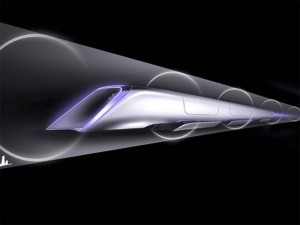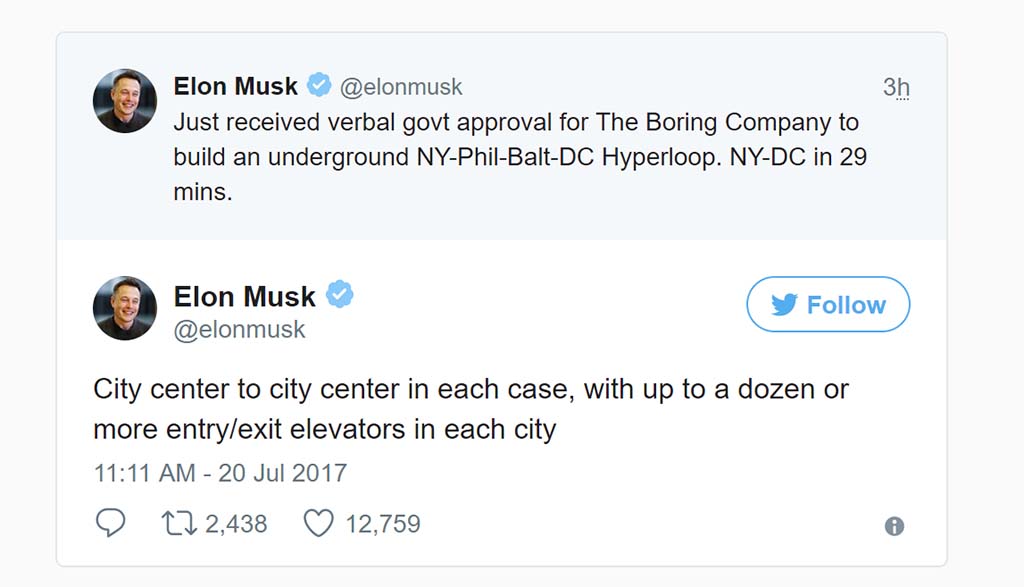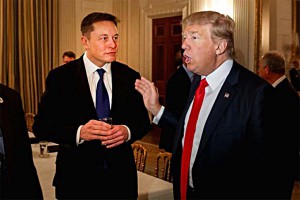You take a quick elevator ride down into a cavern dug well below the busy streets of New York City. A half-hour later you ride back up to the surface, but now you’re in the nation’s capital.
At least that’s the scheme envisioned by entrepreneur Elon Musk, who said in a tweet that he has gotten “verbal govt approval” for his new tunneling venture, the Boring Company to build an underground version of his Hyperloop concept to connect New York and Washington, D.C. Total travel time, he estimated, would be just 29 minutes, or a fraction of what it today takes even by air, never mind the fastest conventional trains operated by Amtrak.
The project would create a revolution in transportation, especially by linking up two major cities on the East Coast. But Musk is also trying to pull together another underground project that would allow motorists to avoid the traffic jams of Los Angeles by traveling through a network of underground tunnels.
Both projects would be spearheaded by the Boring Company, a venture Musk announced earlier this year. He claims the firm is working on ways to both speed up traditional tunnel digging while slashing costs. In the case of the LA effort, vehicles would be diverted off of city streets and drive onto electrified skateboards that would speed them from one part of the city underground to another before being delivered back up to the surface.
The East Coast venture would tap into another concept Musk has been spearheading. The Hyperloop would replace conventional trains with minivan-sized pods that would essentially blast through small tubes. By bringing to near vacuum levels of air pressure there’d be little aerodynamic resistance, allowing them to jet along at nearly supersonic speeds.
Several other companies have been toying with the Hyperloop concept, possibly as an alternative to the high-speed rail line that the California government wants to build to connect cities at both ends of the state.
(Musk may open dozens of auto assembly, battery plants. Click Herefor the story.)
Exactly whom Musk received “verbal govt approval” from has not been released. He was a member of Pres. Donald Trump’s economic advisory council until withdrawing in protest after the president withdraw from the Paris climate accord. But Musk has reportedly maintained strong White House connections.
A Trump spokesman told CNBC that, “We have had promising conversations (with Musk) to date, are committed to transformative infrastructure projects, and believe our greatest solutions have often come from the ingenuity and drive of the private sector.”
According to a series of tweets from Musk – best known as the CEO of electric car company Tesla – he’d like to see work on the NY-DC project begin about the same time as work on the Los Angeles tunnel. City officials there have expressed interest in that project.
Responding to questions from followers of his Twitter feed, he indicated he would “then prob(ably)” turn to tunnels linking Los Angeles and San Francisco, and another project in Texas.
Officials at the Metropolitan Transit Authority, which overseas rail travel in and out of New York, have not yet responded to a request for comment. It would likely require numerous different government entities, at federal, state and local levels, along the route to give Musk approval before work on such an East Coast project could begin.
(For the latest on the launch of the Tesla Model 3, Click Here.)
As for cost, California analysts have projected a budget of as much as $10 billion for just 120 miles of high-speed rail there. And that’s working above ground. Madeline Brozen, associate director of the Institute of Transportation Studies at the University of California Los Angeles, told USA Today the price tag of the New York to D.C. tunnel would be “incomprehensible.”
The world’s longest and deepest rail tunnel, the Gotthard Base Tunnel, which travels 35.5 miles under the Swiss Alps, cost the equivalent of $10 billion. Work began in November 1999, full service beginning only last December.
Other skeptics have said they are not yet convinced that the Hylerloop concept itself will prove viable, especially over long distances. One challenge will be to maintain near outer space levels of vacuum over such a distance. If air rushed into the tube as a pod blasted through at 600-plus mph the results could be catastrophic.
But Musk has proved both willing and able to take on his critics. Tesla this month launched production of the new Model 3, its first long-range, mainstream-priced electric vehicle. If it comes close to meeting its sales targets it would transform the company from a niche to mainstream player.
Meanwhile, his SpaceX rocket launch company recently sent a cargo capsule back into space, the first time such a vehicle has been reused, other than the now-retired U.S. Space Shuttle program. SpaceX has also landed several of its first stage rocket boosters and has begun reusing them in a bid to lower launch costs.
Whether the Boring Company can drive down tunneling costs and overcome other traditional obstacles will be key to pulling off the high-speed transportation revolution Musk wants to begin along the nation’s ocean coasts.
(Click Here for more on Tesla’s plan to build a 100 mW Australian battery backup system to boost use of wind power.)




As unlikely as this appears, it’s hard to bet against Musk.